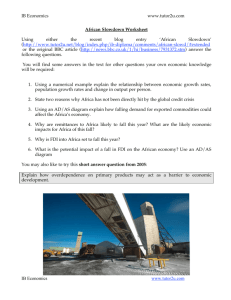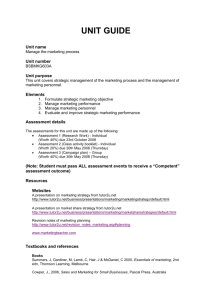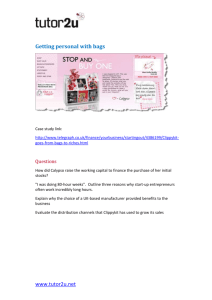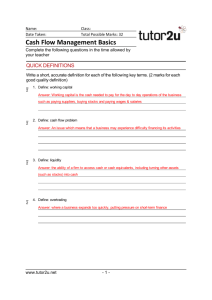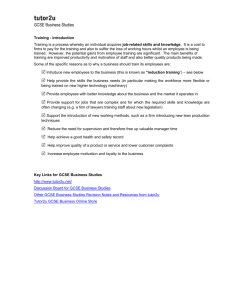A2 Profits And Economic Efficiency
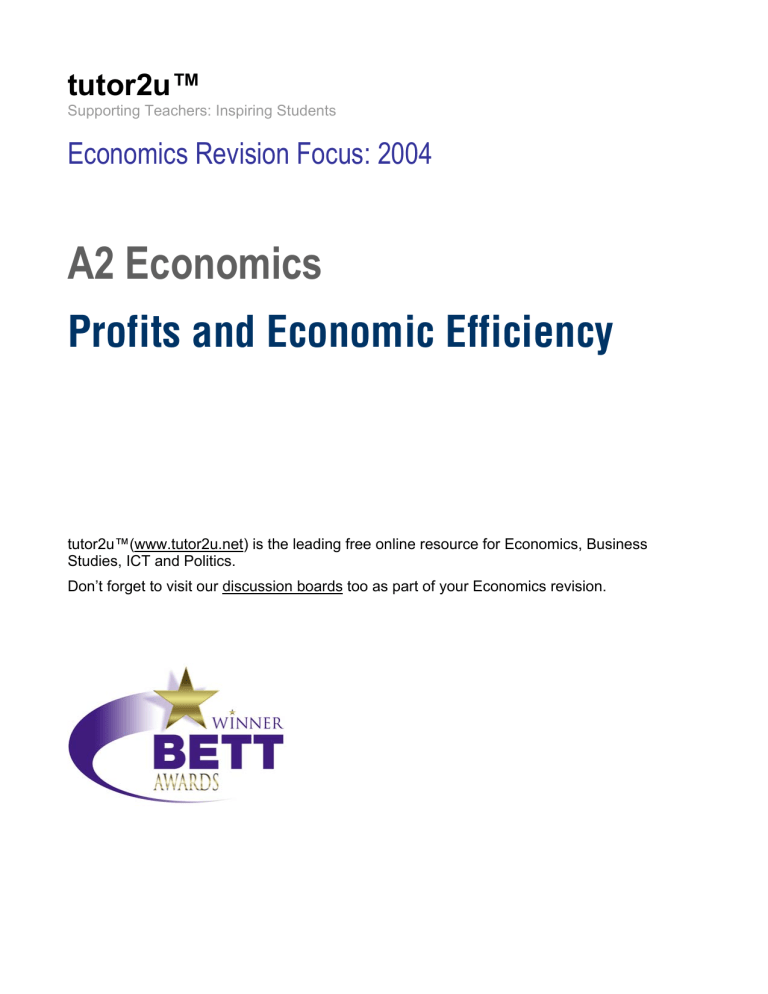
tutor2u™
Supporting Teachers: Inspiring Students
Economics Revision Focus: 2004
A2 Economics
Profits and Economic Efficiency
tutor2u™(www.tutor2u.net) is the leading free online resource for Economics, Business
Studies, ICT and Politics.
Don’t forget to visit our discussion boards too as part of your Economics revision.
tutor2u™
Supporting Teachers: Inspiring Students Page 2 of 7
Profits and Economic Efficiency
Revision Focus on Profits and Economic Efficiency
A2 Syllabus Requirements:
Profits
Candidates should understand the concepts of normal, abnormal and supernormal profit.
They should also understand the role of profit as an incentive to enterprise and in allocating resources
Economic Efficiency
Candidates should understand the conditions required for productive and allocative efficiency . They should understand that dynamic efficiency is influenced by, for example, research and development, investment in human and non-human capital and technological change .
Different concepts of profit
Profit measures the return to risk when committing scarce resources to a particular market or industry.
Entrepreneurs take risks for which they require an adequate expected rate of return . The higher the market risk and the longer they expect to have to wait to earn a positive return, the greater will be the minimum required return that an entrepreneur is likely to demand.
Normal profit is the minimum level of profit required to keep the factors of production in their current use in the long run . Normal profits reflect the opportunity cost of using funds to finance a business. Normal profits are therefore included in the AC curve, thus, if the firm covers its ATC (where AR meets AC) then it is making normal profits.
Sub-normal profit - is any profit less than normal profit (where price < average total cost)
Abnormal profit - is any profit achieved in excess of normal profit - also known as supernormal profit .
When firms are making abnormal profits, there is an incentive for other producers to enter the market to try to acquire some of this profit. Abnormal profit persists in the long run in imperfectly competitive markets such as oligopoly and monopoly where firms can successfully block the entry of new firms www.tutor2u.net
: The Home of Economics on the Internet
tutor2u™
Supporting Teachers: Inspiring Students Page 3 of 7
Costs
Supernormal profits at
Price P1 and output Q1
P1
Normal profit at Q2 where
AR = AC
SRMC
Profits and Economic Efficiency
SRAC
AC1
AC2
AR1
(Demand)
Q1 Q2 Output (Q)
MR1
A change in demand and/or production costs (supply) will lead to a change in the profit maximising price and output. In exams you may often be asked to analyse how changes in demand and costs affect the equilibrium output for a business. Make sure that you are confident in drawing these diagrams and you can produce them quickly and accurately under exam conditions.
In the diagram below we see the effects of an outward shift of demand from AR1 to AR2 (assuming that short run costs of production remain unchanged). The increase in demand causes a rise in the market price from P1 to P2 (consumers are now willing and able to buy more at a given price perhaps because of a rise in their real incomes or a fall in interest rates which has increased their purchasing power) and an expansion of supply (the shift in AR and MR is a signal to firms to move along their marginal cost curve and raise output). Total profits have increased. www.tutor2u.net
: The Home of Economics on the Internet
tutor2u™
Supporting Teachers: Inspiring Students Page 4 of 7
Profits and Economic Efficiency
A rise in demand (a shift in AR and MR) causes an expansion of supply, a higher profit maximising price and an increase in supernormal profits
Costs Profit Max at Price P2
Profit Max at Price P1
SRAC
P2
P1 SRMC
AC1
AC2
AR2
AR1
(Demand)
MR2
Q1 Q2
MR1
Output (Q)
Roles of profit in a market economy
1.
Finance for investment Retained profits remain the most important source of finance for companies undertaking capital investment projects.
2.
Market entry: Rising profits send signals within a market. When the existing firms are earning supernormal profits, this sends a signal that profitable entry may be possible. In contestable markets, we would see a rise in market supply and downward pressure on prices. But in a monopoly, the existing dominant firm may be able to protect their market position
3.
Demand for factor resources: Scarce resources flow where the expected rate of return or profit is highest . In an industry where demand is strong more land, labour and capital are then committed to that sector. Equally in a recession, national output, employment, incomes and investment all fall leading to a squeeze on profit margins and attempts by businesses large and small to cut costs and preserve their market position. In a flexible labour market, a fall in demand can quickly lead to a reduction in planned investment and cut-backs in labour demand www.tutor2u.net
: The Home of Economics on the Internet
tutor2u™
Supporting Teachers: Inspiring Students Page 5 of 7
Economic Efficiency
Profits and Economic Efficiency
For A2, it is important to understand the difference between static and dynamic efficiency and to use economic efficiency concepts when analysing a market (e.g. when drawing cost and revenue curves). For high marks on analysis you will definitely need to make some relevant comments on economic efficiency!
Static efficiency concerns allocative and productive efficiency
Allocative efficiency occurs when
1.
The market meets the needs and wants of consumers
2.
Where the value consumers place on a good (reflected in the price people are willing and able to pay) equals the cost of the resources used up. The condition required is that price = marginal cost
In a competitive market, the equilibrium price balances demand and supply . At the market equilibrium, consumer and producer surplus combined is maximised.
If the producer were to artificially control supply to less than Q1 (e.g. Q2) and charge a higher price, then consumer surplus would fall at the expense of an increase in producer surplus. But in net terms, the total amount of economic welfare would decline, in other words there would be a deadweight loss of welfare.
Allocative efficiency in a competitive market
At the competitive market equilibrium price and output, we maximise consumer and producer surplus. No one can be made better off without making someone else worse off – this is known as the condition required for a Pareto optimal
Costs
Revenues
P2
Consumer
Surplus (CS)
MC (Supply in a competitive market )
P1
Allocative efficient price and output at the market equilibrium
Requires other markets to be competitive as well!
Producer
Surplus (PS)
Average Revenue
(Demand)
Net Loss of
Economic Welfare from price P2 raised above marginal cost
Q2 Q1 Output (Q)
Productive efficiency refers to a firm's costs of production and can be applied both to the short and long run. It is achieved when output is produced at minimum average total cost (ATC). Productive efficiency exists when producers minimise the wastage of resources in their production processes. www.tutor2u.net
: The Home of Economics on the Internet
tutor2u™
Supporting Teachers: Inspiring Students Page 6 of 7
Profits and Economic Efficiency
Internal economies of scale cause a reduction in long run average costs. Long run productive efficiency is reached at the minimum efficient scale (MES) – the output where the available internal scale economies have been exploited
Costs
Revenues
SRAC1
SRAC2
AC1
SRAC3
AC2
AC3
Q1 Q2 Q3 Quantity Produced (Q)
Dynamic efficiency
Dynamic efficiency occurs over time . It focuses on changes in the consumer choice available in a market together with the quality of goods and services provided. Dynamic efficiency will improve
1.
In contestable markets where the discipline of actual and potential competition acts as an incentive for suppliers to be innovative and to meet the changing needs and wants of consumers in order to remain successful in their market. Competition policy therefore has an important role to play as does a commitment to free international trade and open flows of capital between countries
2.
In those industries where significant money is invested in research and development leading to a fast pace of invention and innovation. It is particularly associated in imperfectly competitive markets where a high percentage of sales income is devoted to research and development and where competitiveness and market position is determined largely by the relative success or failure of product and process innovation.
3.
When a country invest in human capital – for example increased resources into higher education which may lead to external economies of scale – for example where corporations and universities engage in joint ventures to fund cutting edge research in potentially high-growth sectors (fuel cell technology for example)
Please refer to the separate revision focus article on the economics of innovation
X-Inefficiency
The economist Libenstein pointed to potential cost inefficiencies arising from a lack of effective competition within a market . These are known as X-inefficiencies and are often used as part of the case www.tutor2u.net
: The Home of Economics on the Internet
tutor2u™
Supporting Teachers: Inspiring Students Page 7 of 7
Profits and Economic Efficiency against monopoly. Companies that face little or no real competition often allow their fixed costs of production to rise – for example by running inefficient administration systems – the result is external diseconomies of scale www.tutor2u.net
: The Home of Economics on the Internet
